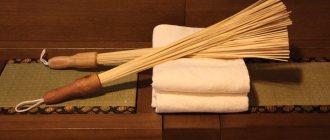Laconicum and ancient philosophy
Hellas was a country where there was a cult of a healthy body. Only in a healthy body can a healthy spirit and divine philosophy live. Only in such a country could Hippocrates appear; only in Ancient Greece could his recommendations on the use of a variety of water procedures become so popular. Numerous excavations of baths and bath complexes confirm Homer’s statements about the love of the Greeks for water procedures.
The Greeks regarded bathing as a sacred act. They sat in the bathtub, unless Hippocrates advised lying down, with their feet in a special recess, and spent no time in it less than the recommended time. They used soaps made from goat fat and ash, aromatic oils, scrapers, and washcloths. The Greeks associated clean skin with physical and mental health.
The first baths appeared in the city of Laconia, in Sparta. These were round rooms with a fireplace in the center. The stove heated natural stones, with the help of tongs additional stones, heated in another room, were brought into the room by slaves, so the temperature was raised to 60°-70°C. The stones were occasionally watered to achieve a humidity of 15-20%.
Laconicum was part of the gymnasium, a sports facility for training and ablutions, and was a means of relaxation and rest after physical exertion. The gymnasium included a palaestra, a place for competitions, and an exedra, a place for philosophical conversations.
The Greek laconium differs from the Roman baths in the modesty of its decoration. The heart of the Greek bath, the room in which the ancient Hellenes steamed, was a rotunda with a truncated dome on top. There was a hole inside the dome that closed when the soaring process was in progress. But the main difference between laconicum and terma was their purpose.
The Greeks viewed the bathhouse exclusively as a medical, hygienic procedure associated with spiritual and bodily cleansing, but not as entertainment. And the Romans embodied in their baths all the thirst for spectacle inherent in the ancient descendants of Romulus and Remus.
What did a classic Greek bath look like?
The Laconicum was a round room, lined with hewn stones. According to the Greeks, rounded shapes contributed best to the uniform distribution of heat throughout the bathhouse. In the center there was an open stone hearth, in which charcoal was used for the fire. Sometimes stones were used, which were heated outside and then brought into the laconicum. To remove smoke, a lid on bronze chains was provided in the dome of the room, which was opened during the fire of the hearth.
A special feature of Greek baths are benches that are heated from the inside.
The body was heated in Greek baths due to the “dry” heat from the stones of the hearth, the coals of the fire, as well as from the hot walls of the room. After active sweating, the Greeks moved on to hygienic procedures for cleansing the body. In this case, wooden, metal or bone scrapers and shears were used, which literally scraped out dirt. This is exactly how the ancient Greeks “washed themselves.”
After steaming, it was recommended to douse yourself with cold water from a jug and begin water procedures in the pool. As a rule, each laconicum contained a shallow pool or, in extreme cases, a bathtub. There was no drainage system at that time, and at the end of the bathing procedure, water was scooped out of the containers. The sharp temperature contrast of the hot heat and cool water of the pool ensured good spirits, cleanliness and health of the body. It’s not for nothing that excellent health is still called Spartan to this day!
Excavations show that baths in Ancient Greece were often part of the gymnasium - the sports complex of the ancient Greeks. The bathhouse was visited after the palestra, where sports competitions were held, to restore strength after physical exercise. Then they went to the exedra, where philosophical conversations were held. Thus, laconicum gradually crossed the hygienic threshold in its meaning and became an attribute of public culture.
Device
Why did the Greeks use the hemispherical shape for their baths? It contributed to the rapid heating of the room, the heat was distributed evenly, the stones that were in the steam room and additionally brought in kept the temperature at a constant level without changes. The chimney, in the form of an opening in a cone-shaped roof, worked properly, in accordance with physical laws, during the heating of the stove, then closed so that the heat did not escape.
Hellas, water cult
The Laconicum included a small pool or bath. There were also several tanks with water of different temperatures for swimming. Men used only cold water, considering warm water unworthy of themselves. It was believed that warm water was for women.
There were no water pipes in the laconiums; water was brought in by hand, scooped up and drained just as easily. Marble lining of trestle beds and sun loungers was considered important; they were located in close proximity to the source of heat and themselves became its emitter, enriching the air with minerals of natural origin.
The principle of the Greek bath is similar to the Russian one, using a heater, draft, and also a method of steam generation. The only difference is in the temperature level, the Greeks preferred moderate heat, while in the Russian bathhouse the heat is strong and the temperatures are high.
Like Roman baths, Hellenic laconicums were places of meetings and conversations. In additional rooms for massage and relaxation, philosophical and business conversations were held, pressing issues were resolved, and acquaintances were made.
Laconicum - Greek bathhouse
Mention of the origin and use of ancient Greek baths is found in chronicles more than 2000 years ago. Herodotus of Halicarnassus, the famous ancient Greek historian, wrote about the importance of steam and baths in human life in the 5th century BC. Archaeological finds, such as the remains of buildings, are evidence that water procedures were an integral part of the life of the ancient Greeks. And the drawings on the dishes and vases also demonstrate this. The ancient Greeks attached religious and mystical significance to water.
Drawings on ancient Greek vases
The ancient Greeks preached the cult of a healthy mind and body. Homer also noted in his work “The Iliad” the Greeks’ love of bathing. The ancient Greeks had a tradition - the bride, before her marriage, was obliged to swim in the water of a fountain in Athens. It was filled with water through nine pipes.
Beautifully preserved bath in Side
The founder of modern medicine, Hippocrates, always attached great importance to water procedures. He has many recommendations for using saunas and baths to improve a person’s health. Archaeologists, during excavations of Greek cities, found well-preserved baths of various shapes and sizes.
The Greeks respected Hippocrates and followed his recommendations. He argued that sitting in a bath was much more beneficial than lying down. Therefore, the person taking the bath had to sit upright and place his feet in a special recess at the bottom of the bathtub. Over time, the Greek bath became an element of everyday culture.
Archaeological find – fragment of a bathtub
The open hearth in the Greek bath was in the middle of the room. The bathroom was heated by the warmth of an open fire. In the bathhouse, in addition to the bathtub, there were pools with cold water. The Greeks had accessories that they used in the bath: soap, aromatic oils, incense, scrapers and washcloths. Men did not bathe in warm water; they considered it a feminine weakness and preferred to water themselves only with cold water.
The Greeks were the first to use hot water and steam for clean skin, good spirits and healthy bodies. Therefore, the history of the bathhouse begins in Greece. It was they who came up with a complex of thermal and water procedures. There is no reliable information regarding the origin of steam baths in ancient Greece. Only one thing is certain - they appeared in Sparta. If we take as a basis what the Greeks call the steam bath “laconicum”, we can say that its homeland is the city of Laconicum.
The word hygiene comes from the name of the daughter of the ancient Greek god of healing Asclepius - Hygeia (from the Greek word hygieinos - healthy) - the goddess of purity and health.
The daughter of the healer god Asclepius is the ancient Greek goddess of purity and health Hygeia
Bathhouse in Greek
The epic of Ancient Greece, which described bath procedures, gives us the opportunity to learn the methodology for taking bath procedures at that time. During a military campaign against Egypt, the famous commander Alexander the Great saw Egyptian baths. He liked them very much. Returning from the campaign, he ordered the same comfortable baths to be built in his homeland. This is how oriental-type baths with heated floors spread in Greece.
The ancient Greek baths were also a hospital, in which both nobles and ordinary people got rid of many ailments. The more baths there were in Greece, the richer and more comfortable they became. The materials from which they were built were very expensive. There was also a fashion to decorate them with precious stones. These baths were intended only for rich and noble residents. Laconicums are considered a traditional Greek bath.
Bathhouse in Greek “laconicum”
Greek baths were built from cut stones in the form of a round building. Uniform and quick heating was achieved thanks to the round shape of the bath. An open hearth, made of stones, was located in the center of the room and was heated with charcoal. And sometimes, the stones were heated outside, then they were brought into the bathhouse. The smoke was discharged through a hole in the dome of the building; the hole was opened and closed using a lid, which was opened with the help of chains while the bath was heating.
In these baths, the human body was warmed by dry heat from the coals, as well as from the stones of the hearth and the walls of the bath. After taking paired procedures, the Greeks doused themselves with cold water and made the transition to the bath. For every Greek bathhouse, laconicum, a prerequisite was a small swimming pool or something like a bath. Water had to be scooped out and poured only by hand, since there were no drainage systems. The difference in temperature in a hot steam bath and a cold bath had a beneficial effect on the spirit and body of the ancient Greeks.
Mandatory swimming pool for laconicum
Sparta has always been famous for its traditions and high level of physical culture. Archaeological excavations have shown that the ancient Greek baths laconicum were part of a whole complex of sports facilities called the gymnasium. The Greeks attached great importance to the development of physical abilities and strengthened their spiritual and physical health through sports.
After competitions in the palaestra, a visit to the bathhouse was mandatory, where the Greeks regained strength after sports activities. And after recovery and relaxation in the bathhouse, they went to the exedra for a pleasant pastime and pleasant philosophical conversations. Therefore, the Greek baths lakonicum from structures for hygiene and health became cultural centers of Ancient Greece.
Laconicum
Today, the Greek bathhouse lakonicum is a type of bathhouse with its own national characteristics. As a rule, the interior space of the laconicum is finished with natural stone or ceramic tiles. The heat and warmth in such baths comes from heated benches. The temperature in such baths is not very high - up to 70-75 degrees, air humidity is 15-20%. You can stay in the laconicum for a long time, longer than in most baths in the world.
The human body warms up slowly and evenly. Neither the skin nor the circulatory system are overloaded by temperature differences. In the laconicum you can calmly rest and relax, enjoying peace and soft warmth.
Greek bath – laconicum
Features of the procedure
The functionality of the Greek bath came first. After a competition or training, the Greeks, covered in oil, dusty, and sweaty, rushed to bathe and cleanse their skin. The bath conditions contributed to the effective cleansing of the skin. Steamed with the help of scrapers and washcloths, the Greeks practiced hygiene, fulfilling the requirements of the goddess of beauty and health Hygieia, daughter of Asclepius.
Laconium ruins
The cleansing process alternated with the hardening process. The steam room was followed by contrasting procedures of a cold bath, in which the Hellenes could sit for quite a long time. This was followed by a massage and a pleasant process in all respects, when the body was anointed with oils. A Hellene who had undergone a similar purification procedure was considered admitted to the exedra for sublime conversations.
A distinctive feature of the Greek bath is the uniform heating of the body; the warmth that embraces a person from all sides does not injure him and allows him to stay in the steam room for a long time.
Features of bath procedures
In Ancient Greece, people usually visited the bathhouse after performing physical exercises in the gymnasium. After this, you should rub your body with olive oil and head to the steam room. There, having sweated thoroughly, the visitor began to cleanse the body, using metal shears - antique analogues of modern washcloths, only in a more severe design. In this simple way, old, dead epidermal cells, softened by oil and sweat, easily rolled off and were removed.
Contrast procedures were held in incredible esteem at that time. Immediately after steaming, the ancient Greeks plunged into the cold water of a pool (bath) and sat there (usually they sat in such pools, since they were too shallow to swim there) for hours. It was also possible to take warm water procedures, but this was largely the prerogative of women.
After the bath procedures, the skin was rubbed with incense, they put on clean clothes and, ideally, went to have philosophical conversations in the squadron.
In a modern Greek bath, all these conventions are useless. When you enter the laconicum (sometimes, if they are part of bath complexes, they are simply called “Greek halls”), get ready to just relax. Profuse sweating does not begin immediately, but after 15-20 minutes, as the body warms up gradually. The temperature is not too high! Together with sweat, toxins and harmful substances leave the body, the skin is cleansed, and its enhanced regeneration occurs. After steaming, you should go to the shower and, under a cool shower, wash off the remaining sweat. The following procedures include swimming in the pool and relaxation in the relaxation room.
The benefits and harms of Greek laconicum
The conditions of a Greek bath are extremely beneficial for the human body, without radical temperature changes, without extreme heat, without an ice bath - the gentle conditions have no contraindications for use. Anyone, old and young, healthy and sick, can take a steam bath in Laconicum, unless there are individual contraindications.
The Greek bath is useful because:
- removes toxins and waste;
- relieves pain symptoms;
- accelerates metabolic processes;
- calms the nervous system;
- stabilizes blood pressure;
- relieves insomnia and depression;
- treats the musculoskeletal system.
Conditions that are comfortable for the body relieve cardiovascular stress and do not put the heart at risk. A person does not sweat immediately; sweating begins after 20-25 minutes of exposure. The person calms down, becomes relaxed, and relaxation begins.
Laconicum is perhaps the only bathhouse that patients with chronic diseases can visit.
Greek bath - laconicum: from antiquity to the present day
The first baths appeared in Greece long before the beginning of our era. According to legend, their founder was Alexander the Great, who during his campaign against Egypt (330s BC) became addicted to the local bathhouse traditions. The Macedonian king liked the Egyptian baths so much that upon his return to Greece, he launched large-scale construction of similar baths throughout the country. This is how the Greek baths appeared - laconiums, which very quickly gained popularity and became the center of the cultural life of the population.
Greek bath today
It is not difficult to reproduce exactly the original conditions of the Greek laconicum today. A round or oval room is required with a stove-stove in the center, steam pumped by a steam generator to the required values, and massive stone sun loungers. Maintaining temperatures up to 75° and humidity up to 20% is also possible. As for contrasting procedures, you don’t need a massive pool, a bath or an ordinary font with heated water is enough.
Today you can find decent Greek baths. In large health complexes, salons, and fitness centers, it is practiced to create conditions for the harmony of the Greek bath. The cost per hour ranges from 1000 to 1500 rubles. Since a stay in a modern Greek bath requires at least 4 hours (a long stay in the steam room, a long stay in the pool and only then rest), the pleasure is expensive.
Modern Greek bath
Modern interpretation - new Greek baths
Modern Greek baths are not as popular as saunas or Turkish hammams (which, by the way, are direct descendants of laconium). Usually they are part of large bath complexes or spa centers and very rarely are independent units.
Laconiums being built these days consist of several rooms: a relaxation room, a steam room, a washing room with pools, baths, and a shower. Their interior decoration is stylized as antique. All surfaces are tiled, natural stone or mosaic. The walls are decorated with images of ancient Greek gods and mythical creatures. Often all this splendor is complemented by tall (as tall as a person) antique statues, classical columns, and arches.
If you want to look at the most beautiful baths in the world, we recommend that you read the article
Modern laconicum is often considered a type of sauna. This opinion arose due to the fact that the climate of these two types of baths is really similar and is characterized by high temperature combined with low humidity. But, if in a Finnish sauna the body can get stressed due to the heat (t=80-110°C), then in the laconicum the temperature regime is more gentle (t=60-75°C).
More information about the Finnish sauna can be found here:
Due to the low humidity, not exceeding 15-20%, the laconicum climate is very easily tolerated. Perhaps even easier than the mild climate of the hammam. The body in a Greek bath warms up slowly, but deeply and evenly, without injuring the blood vessels and skin. Therefore, you can rest here for at least an hour - there will be no unpleasant consequences for the body, only complete benefits!
Japanese baths
Therefore, speaking about the Japanese bath, we will see how different it is from everyone else. The Japanese respect and respect the laws of their religion, and she is against the killing of animals. But soap is made from animal fat. Therefore, the Japanese washed themselves without soap, but with very hot water.
There were also prohibitions in Japanese baths. People with skin diseases or mental disorders were prohibited from visiting the bathhouse. In addition, in the Japanese bath they did not drink, did not eat, kept silence, did not have sex and did not relieve themselves.
Bath in Japan










